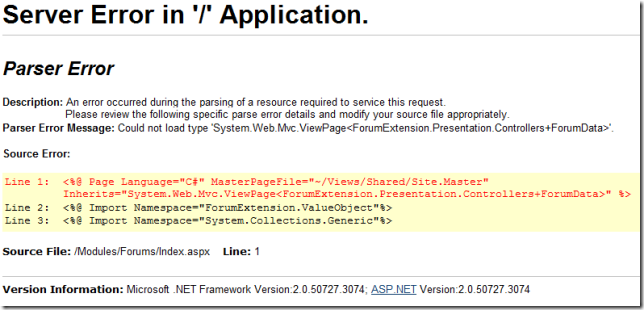Revised: ASP.NET MVC and the Managed Extensibility Framework (MEF)
Edit on GitHubA while ago, I did a blog post on combining ASP.NET MVC and MEF (Managed Extensibility Framework), making it possible to “plug” controllers and views into your application as a module. I received a lot of positive feedback as well as a hard question from Dan Swatik who was experiencing a Server Error with this approach… Here’s a better approach to ASP.NET MVC and MEF.
The Exception
The stack trace was being quite verbose on this one:
InvalidOperationException
The view at '~/Plugins/Views/Demo/Index.aspx' must derive from ViewPage, ViewPage<TViewData>, ViewUserControl, or ViewUserControl<TViewData>.
at System.Web.Mvc.WebFormView.Render(ViewContext viewContext, TextWriter writer) at System.Web.Mvc.ViewResultBase.ExecuteResult(ControllerContext context) at System.Web.Mvc.ControllerActionInvoker.InvokeActionResult(ControllerContext controllerContext, ActionResult actionResult) at System.Web.Mvc.ControllerActionInvoker.<>c__DisplayClass11.<InvokeActionResultWithFilters>b__e() at System.Web.Mvc.ControllerActionInvoker.InvokeActionResultFilter(IResultFilter filter, ResultExecutingContext preContext, Func`1 continuation) at System.Web.Mvc.ControllerActionInvoker.<>c__DisplayClass11.<>c__DisplayClass13.<InvokeActionResultWithFilters>b__10() at System.Web.Mvc.ControllerActionInvoker.InvokeActionResultWithFilters(ControllerContext controllerContext, IList`1 filters, ActionResult actionResult) at System.Web.Mvc.ControllerActionInvoker.InvokeAction(ControllerContext controllerContext, String actionName) at System.Web.Mvc.Controller.ExecuteCore() at System.Web.Mvc.ControllerBase.Execute(RequestContext requestContext) at System.Web.Mvc.ControllerBase.System.Web.Mvc.IController.Execute(RequestContext requestContext) at System.Web.Mvc.MvcHandler.ProcessRequest(HttpContextBase httpContext) at System.Web.Mvc.MvcHandler.ProcessRequest(HttpContext httpContext) at System.Web.Mvc.MvcHandler.System.Web.IHttpHandler.ProcessRequest(HttpContext httpContext) at System.Web.HttpApplication.CallHandlerExecutionStep.System.Web.HttpApplication.IExecutionStep.Execute() at System.Web.HttpApplication.ExecuteStep(IExecutionStep step, Boolean& completedSynchronously)
Our exception seemed to be thrown ONLY when the following conditions were met:
- The View was NOT located in ~/Views but in ~/Plugins/Views (or other path)
- The View created in our MEF plugin was strong-typed
Problem one… Forgot to register ViewTypeParserFilter…
Allright, go calling me stupid… Our ~/Plugins/Views folder was not containing the following Web.config file:
[code:c#]
<?xml version="1.0"?>
<configuration>
<system.web>
<httpHandlers>
<add path="*" verb="*"
type="System.Web.HttpNotFoundHandler"/>
</httpHandlers>
<!--
Enabling request validation in view pages would cause validation to occur
after the input has already been processed by the controller. By default
MVC performs request validation before a controller processes the input.
To change this behavior apply the ValidateInputAttribute to a
controller or action.
-->
<pages
validateRequest="false"
pageParserFilterType="System.Web.Mvc.ViewTypeParserFilter, System.Web.Mvc, Version=1.0.0.0, Culture=neutral, PublicKeyToken=31BF3856AD364E35"
pageBaseType="System.Web.Mvc.ViewPage, System.Web.Mvc, Version=1.0.0.0, Culture=neutral, PublicKeyToken=31BF3856AD364E35"
userControlBaseType="System.Web.Mvc.ViewUserControl, System.Web.Mvc, Version=1.0.0.0, Culture=neutral, PublicKeyToken=31BF3856AD364E35">
<controls>
<add assembly="System.Web.Mvc, Version=1.0.0.0, Culture=neutral, PublicKeyToken=31BF3856AD364E35" namespace="System.Web.Mvc" tagPrefix="mvc" />
</controls>
</pages>
</system.web>
<system.webServer>
<validation validateIntegratedModeConfiguration="false"/>
<handlers>
<remove name="BlockViewHandler"/>
<add name="BlockViewHandler" path="*" verb="*" preCondition="integratedMode" type="System.Web.HttpNotFoundHandler"/>
</handlers>
</system.webServer>
</configuration>
[/code]
Now why would you need this one anyway? Well: first of all, you do not want your views to expose their source code. Therefore, we add the HttpNotFoundHandler for this folder. Next, we do not want request validation to happen again (because this is already done when invoking the controller). Next: we want the MvcViewTypeParserFilter to be used for enabling strong-typed views (more on this by Phil Haack).
Problem two: MEF’s approach to plugins and ASP.NET’s approach to rendering views…
When compiling a view, ASP.NET dynamically compiles the markup into a temporary assembly, after which it is rendered. This compilation process knows only the assemblies loaded by your web application’s AppDomain. Unfortunately, assemblies loaded by MEF are not available for this compilation process… I went ahead and checked with Reflector if we could do something about this on ASP.NET side: nope. The main classes we need for this are internal :-( The MEF side could be easily tweaked since its source code is available on CodePlex, but… it’s still subject to change and will be included in .NET 4.0 as a framework component, which would limit my customizations a bit for the future.
Now let’s describe this problem as one, simple sentence: we need the MEF plugin assembly loaded in our current AppDomain, available for all other components in the web application.
The solution to this: I want a MEF DirectoryCatalog to monitor my plugins folder and load/unload the assemblies in there dynamically. Loading should be no problem, but unloading… The assemblies will always be locked by my web server’s process! So let’s go for another approach: monitor the plugins folder, copy the new/modified assemblies to the web application’s /bin folder and instruct MEF to load its exports from there. The solution: WebServerDirectoryCatalog. Here’s the code:
[code:c#]
public sealed class WebServerDirectoryCatalog : ComposablePartCatalog
{
private FileSystemWatcher fileSystemWatcher;
private DirectoryCatalog directoryCatalog;
private string path;
private string extension;
public WebServerDirectoryCatalog(string path, string extension, string modulePattern)
{
Initialize(path, extension, modulePattern);
}
private void Initialize(string path, string extension, string modulePattern)
{
this.path = path;
this.extension = extension;
fileSystemWatcher = new FileSystemWatcher(path, modulePattern);
fileSystemWatcher.Changed += new FileSystemEventHandler(fileSystemWatcher_Changed);
fileSystemWatcher.Created += new FileSystemEventHandler(fileSystemWatcher_Created);
fileSystemWatcher.Deleted += new FileSystemEventHandler(fileSystemWatcher_Deleted);
fileSystemWatcher.Renamed += new RenamedEventHandler(fileSystemWatcher_Renamed);
fileSystemWatcher.IncludeSubdirectories = false;
fileSystemWatcher.EnableRaisingEvents = true;
Refresh();
}
void fileSystemWatcher_Renamed(object sender, RenamedEventArgs e)
{
RemoveFromBin(e.OldName);
Refresh();
}
void fileSystemWatcher_Deleted(object sender, FileSystemEventArgs e)
{
RemoveFromBin(e.Name);
Refresh();
}
void fileSystemWatcher_Created(object sender, FileSystemEventArgs e)
{
Refresh();
}
void fileSystemWatcher_Changed(object sender, FileSystemEventArgs e)
{
Refresh();
}
private void Refresh()
{
// Determine /bin path
string binPath = Path.Combine(AppDomain.CurrentDomain.BaseDirectory, "bin");
// Copy files to /bin
foreach (string file in Directory.GetFiles(path, extension, SearchOption.TopDirectoryOnly))
{
try
{
File.Copy(file, Path.Combine(binPath, Path.GetFileName(file)), true);
}
catch
{
// Not that big deal... Blog readers will probably kill me for this bit of code :-)
}
}
// Create new directory catalog
directoryCatalog = new DirectoryCatalog(binPath, extension);
}
public override IQueryable<ComposablePartDefinition> Parts
{
get { return directoryCatalog.Parts; }
}
private void RemoveFromBin(string name)
{
string binPath = Path.Combine(AppDomain.CurrentDomain.BaseDirectory, "bin");
File.Delete(Path.Combine(binPath, name));
}
}
[/code]
Download the example code
First of all: this was tricky, and the solution to it is also a bit tricky. Use at your own risk!
You can download the example code here: RevisedMvcMefDemo.zip (1.03 mb)
This is an imported post. It was imported from my old blog using an automated tool and may contain formatting errors and/or broken images.


.aspx)

0 responses